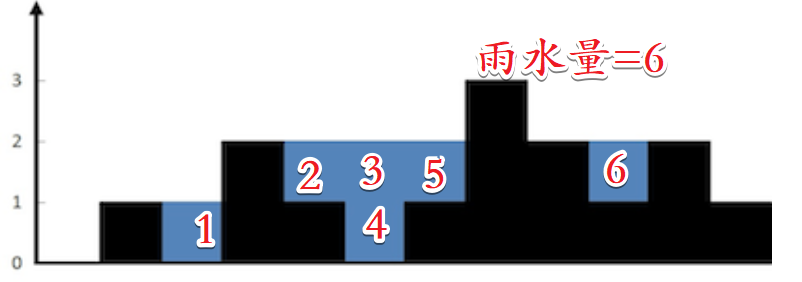题目描述
给定 n 个非负整数表示每个宽度为 1 的柱子的高度图,计算按此排列的柱子,下雨之后能接多少雨水。
我的题解
关键在于找到全部可以装雨水的'槽'
从第一个柱子开始,寻找第一个比它高的,即可组成一个槽。
如果没有更高的,就找到后面最高的,这时也可以组成一个槽
//99.98%
public int trap(int[] height) {
int len = height.length;
int rainCount = 0;//雨量
for (int i=0;i<len-1;i++){
if (height[i+1]>height[i])continue;//如果这个柱子比下一个低,跳过。
int highter = height[i];//后面更高的柱子高度
int highterIndex = i;//后面更高的柱子索引
int max = height[i+1];//后面的最高柱子
int maxIndex = i+1;//后面的最高柱子索引
boolean hasHighter = false;//后面是否存在比当前柱子更高的柱子
for (int j=i+1;j<len;j++){
if (height[j]>=highter){//找到不低于当前柱子的柱子
highterIndex = j;
hasHighter = true;
break;
}
if (height[j]>max){//计算后面最高的
max = height[j];
maxIndex = j;
}
}
if (!hasHighter) {//如果后面没有更高的柱子,就是用后面的最高柱子
highterIndex = maxIndex;
highter = max;
}
for (int j=i+1;j<highterIndex;j++){//计算这个槽可以积累的雨量
rainCount+=highter-height[j];
}
i=highterIndex-1;//跳到这个槽的右边柱子
}
return rainCount;
}
分析:
时间复杂度:O(N),虽然看似有来两个循环,但是他们是线性的
空间复杂度: O(1),只使用了几个变量而已
其他解法
单调栈
public class Solution {
public int trap(int[] height) {
if (height == null) {
return 0;
}
Stack<Integer> stack = new Stack<>();
int ans = 0;
for (int i = 0; i < height.length; i++) {
while(!stack.isEmpty() && height[stack.peek()] < height[i]) {
int curIdx = stack.pop();
// 如果栈顶元素一直相等,那么全都pop出去,只留第一个。
while (!stack.isEmpty() && height[stack.peek()] == height[curIdx]) {
stack.pop();
}
if (!stack.isEmpty()) {
int stackTop = stack.peek();
// stackTop此时指向的是此次接住的雨水的左边界的位置。右边界是当前的柱体,即i。
// Math.min(height[stackTop], height[i]) 是左右柱子高度的min,减去height[curIdx]就是雨水的高度。
// i - stackTop - 1 是雨水的宽度。
ans += (Math.min(height[stackTop], height[i]) - height[curIdx]) * (i - stackTop - 1);
}
}
stack.add(i);
}
return ans;
}
}
